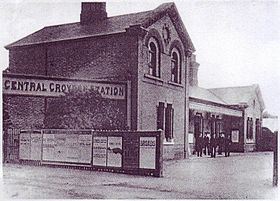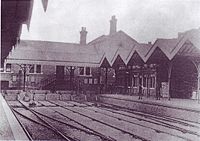- Croydon Central railway station
-
Coordinates: 51°22′20″N 0°5′59″W / 51.37222°N 0.09972°W
Croydon Central 
Location Place Croydon Local authority Croydon History Opened by London, Brighton and South Coast Railway Platforms 2 Key dates Opened 1 January 1868
Closed 1 December 1871
Reopened 1 June 1886
Closed 1 September 1890[1][2]Replaced by none Croydon Central station was a railway station in Croydon, Surrey, now in South London, England. It was a largely unsuccessful venture by the London Brighton and South Coast Railway to bring trains closer to the centre of Croydon, as East Croydon station was deemed too far from the busy town centre.
Contents
Authorisation
In 1839, Croydon, then a thriving market town of around 20,000 inhabitants strategically situated on the southern fringe of London, was first connected with the rapidly-expanding railway network when the London and Croydon Railway opened a station (now known as West Croydon) near London Road. Two years later, the London and Brighton Railway opened a rival station (now known as East Croydon) on the other side of town. Both stations were a fair distance from the centre of Croydon and the local stage coach, previously the dominant mode of transport in the area and now undercut by the railway, sought to create new business by ferrying passengers to and from the stations.[3]
This situation prevailed until 1863 when, under pressure from local townspeople to provide a more convenient station, the London, Brighton and South Coast Railway (LBSCR) (formed in 1846 by a merger between the two rival companies) promoted the London, Brighton and South Coast Railway (Additional Powers) Bill which, amongst other matters, sought authorisation for the construction of a branch spur from East Croydon station to Katharine Street where a new "Central Station" would be built. The Act passed into law on 29 July 1864 and the railway company began purchasing the land necessary for its station. Annexed to the bill was a plan of the area required by the railway: this took in a whole block between the present-day Mint Walk and Katharine Street right up to the High Street. The line and station were initially intended not to run parallel with Katharine Street but instead to approach it at an angle. A subsequent realignment of the route made it parallel with Katharine Street, thereby reducing the amount of land needing to be purchased. The plot of land to the west of Park Street was purchased for a total sum of £11,217 and a contract was awarded to Messrs John T Chappell of Steyning to construct the line and station for £4,089.[3]
The short branch line left the Brighton Main Line just south of George Street and curved sharply west, where the Fairfield Halls are today. It passed under Park Lane, through the Queen's Gardens and continued to the site of the Croydon Clocktower and Town Hall.
Operations
 Only known photograph of the Station interior showing track layout and crossovers
Only known photograph of the Station interior showing track layout and crossovers
Opened on 1 January 1868[4], the station, known as Croydon Central, was served by platforms 1 and 2 of "New Croydon Station" (an extension of East Croydon station dealing with local traffic). Initially, twelve trains per day worked the line to and from London Bridge. However, for passengers wishing to travel south or use other routes, it remained more convenient to go to East or West Croydon. The commercial judgement that created Croydon Central was therefore unrewarded and services ceased after three years on 1 December 1871[4]. The facility remained mothballed until 1 June 1886[4] when, under pressure from the Council, it was reopened to traffic. Around this time, the LBSCR had sought to improve the usefulness of the short branch by extending it under the High Street to curve around to the right to join up with the West Croydon - Epsom line at West Croydon station. This plan, which might have seen Croydon Central become a viable station, was never realised.[3]
The reopening of the station (which was now renamed Central Croydon) in 1886 did not coincide with the reintroduction of passenger services by the LBSCR; instead, two other railway companies, the London & North Western Railway and the Great Eastern Railway, worked the line and provided, by all accounts, a generally poor service. The withdrawal of services on 1 September 1890 came therefore as little surprise to the local community; they had hoped that the railway would give impetus to the development of the High Street, but this never materialised and ironically it was only after the demolition of the station that plans for the area could be advanced. In fact, two years before the reopening of the station, a "High Street Improvement Committee" had been set up with the aim of carrying out necessary civic improvements such as the widening of the High Street and the laying of a tram connection. The station, which occupied the main road frontage, stood in the way of these proposals.[3]
Anxious to rid themselves of an unprofitable connection, in 1889 the LBSCR offered the railway land for sale at a price of £12,500. An eventual figure of £11,500 was agreed on condition that the railway company leave in place the retaining walls of their facility which were supporting part of Katharine Street. On the large plot of land, the Council intended to erect their Municipal Offices, Courts, a Police Station and Library, hoping that the presence of public facilities on part of the land would increase the development value of the remainder. By 1890, the necessary agreements and consents for the sale were in place, drawing to a close Croydon Central's short history.[3]
The site today
The site of the station is now occupied by the Town Hall. A short section of landscaped cutting and some of the retaining walls for the railway can be seen in the Queen's Gardens, no further trace of the station's existence remains. A plaque has been fixed to the retaining wall of the garden marking its significance.
Gallery
References
- ^ Greater London Industrial Archaeology Society - Accessed 6 December 2007
- ^ London Borough of Croydon - Accessed 6 December 2007
- ^ a b c d e London Borough of Croydon (Parks Department) (June 1983). The Queen's Gardens. pp. 6–12. ISBN X000231974.
- ^ a b c Butt, R.V.J. (1995). The Directory of Railway Stations, Patrick Stephens Ltd, Sparkford, ISBN 1-85260-508-1, p. 57.
Categories:- Disused railway stations in Croydon
- Railway stations opened in 1868
- Railway stations closed in 1890
Wikimedia Foundation. 2010.







